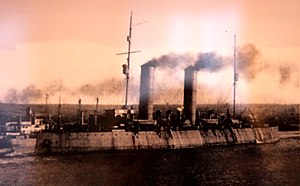Krasin (1916 icebreaker)

Icebreaker Svyatogor (renamed Krassin) as built in 1917
|
|
| History | |
|---|---|
|
|
|
| Name: | Svyatogor then Krassin |
| Namesake: | Leonid Krasin |
| Owner: | Imperial Russian Navy, then Soviet Navy |
| Builder: | Armstrong Whitworth, Newcastle upon Tyne |
| Yard number: | A/W 904 |
| Launched: | 3 August 1916 |
| Completed: | February 1917 |
| Fate: | museum ship in Saint Petersburg |
| General characteristics | |
| Class and type: | Icebreaker |
| Tonnage: | GRT 6,048 tons and NRT 1,687 tons |
| Displacement: | 4,220 tonnes deadweight (DWT) |
| Length: | 99,80 m |
| Beam: | 21,65 m |
| Draft: | 7,5 m |
| Armament: | (in World War II) four 76mm guns, seven 20mm AA guns, 10 large caliber machine guns |
| Notes: | |
The first icebreaker Krassin (Russian: Красин) was built for the Imperial Russian Navy as Svyatogor. She had a long, distinguished career in rescue operations, as well as a pathfinder and explorer of the Northern Sea Route. She has been fully restored to operating condition and is now a museum ship in Saint Petersburg.
The icebreaker was built by Armstrong Whitworth in Newcastle upon Tyne under the supervision of Yevgeny Zamyatin. The vessel was launched as the Svyatogor on 3 August 1916 and completed in February 1917. Up to the beginning of the 1950s she remained the most powerful icebreaker in the world.
During the allied intervention against the Bolsheviks in Northern Russia (1918–19) she was scuttled by the Royal Navy. They raised her for use in the White Sea and later brought her from Devonport to Scapa Flow for crushing hurdles put up to prevent German submarines entering. minesweeping.
Svyatogor was returned to the USSR under the Krassin trade agreement in 1921. In 1927 this icebreaker was renamed by the Soviet government to honor a recently deceased early Bolshevik leader and Soviet diplomat Leonid Krasin.
Perhaps the most famous duty the Krassin performed was rescuing General Umberto Nobile and his surviving crew when their airship Italia crashed on the ice upon returning from the North Pole in 1928. Later in the same year, Krassin rescued the German passenger ship Monte Cervantes, with 1835 passengers on board, after it hit an iceberg and its hull was severely damaged.
...
Wikipedia
